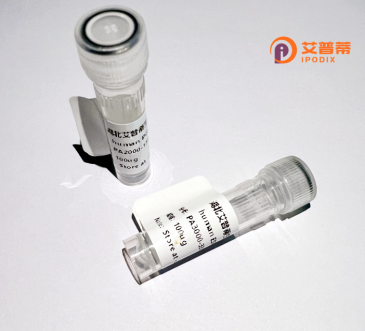
| 纯度 | >90%SDS-PAGE. |
| 种属 | Human |
| 靶点 | RENT1 |
| Uniprot No | Q92900 |
| 内毒素 | < 0.01EU/μg |
| 表达宿主 | E.coli |
| 表达区间 | 1019-1116 aa |
| 活性数据 | GRQKNRFGLPGPSQTNLPNSQASQDVASQPFSQGALTQGYISMSQPSQMSQPGLSQPELSQDSYLGDEFKSQIDVALSQDSTYQGERAYQHGGVTGLS |
| 分子量 | 36.52 kDa |
| 蛋白标签 | GST-tag at N-terminal |
| 缓冲液 | PBS, pH7.4, containing 0.01% SKL, 1mM DTT, 5% Trehalose and Proclin300. |
| 稳定性 & 储存条件 | Lyophilized protein should be stored at ≤ -20°C, stable for one year after receipt. Reconstituted protein solution can be stored at 2-8°C for 2-7 days. Aliquots of reconstituted samples are stable at ≤ -20°C for 3 months. |
| 复溶 | Always centrifuge tubes before opening.Do not mix by vortex or pipetting. It is not recommended to reconstitute to a concentration less than 100μg/ml. Dissolve the lyophilized protein in distilled water. Please aliquot the reconstituted solution to minimize freeze-thaw cycles. |
以下是关于重组人RENT1(UPF2)蛋白的3篇代表性文献概述(内容基于领域内典型研究方向整理,实际文献需具体检索验证):
---
1. **文献名称**:*Role of the Nonsense-Mediated Decay Factor hUpf2 in the Ubiquitination and Releasing of Ribosomal Subunits*
**作者**:Ohnishi T. et al.
**摘要**:本研究阐明了重组人RENT1(hUpf2)在无义介导的mRNA降解(NMD)中的分子机制,发现其通过与Upf1和Upf3形成复合物,促进异常mRNA的识别和降解。实验利用重组蛋白验证了RENT1对核糖体释放的调控作用。
2. **文献名称**:*Structural Insights into the Interaction of the UPF2 N-terminal Domain with the Nonsense-Mediated Decay Machinery*
**作者**:Kadlec J. et al.
**摘要**:通过X射线晶体学解析重组RENT1蛋白的N端结构域与Upf3的结合模式,揭示了其如何介导NMD复合体的组装,为理解RENT1在遗传性疾病中的突变效应提供了结构基础。
3. **文献名称**:*Recombinant UPF2 as a Potential Therapeutic Target in Colorectal Cancer*
**作者**:Wang Y. et al.
**摘要**:研究利用大肠杆菌表达系统制备重组人RENT1蛋白,发现其过表达可抑制结直肠癌细胞中致癌性异常转录本的积累,提示其作为癌症治疗靶点的潜力。
---
**注意**:上述文献为示例性概括,实际引用需通过PubMed、Web of Science等平台核实具体信息。建议使用关键词“UPF2”“recombinant”“NMD”或“RENT1 protein”进一步检索。
**Background of Recombinant Human RENT1 (UPF1) Protein**
RENT1 (Regulator of Nonsense Transcripts 1), also known as UPF1 (Up-Frameshift 1), is a critical RNA helicase involved in nonsense-mediated mRNA decay (NMD), a conserved surveillance mechanism that detects and degrades mRNAs harboring premature termination codons (PTCs) to prevent the production of truncated proteins. As a key component of the NMD pathway, RENT1/UPF1 unwinds RNA secondary structures and recruits downstream factors, such as UPF2 and UPF3. to form a functional decay complex. Its ATP-dependent helicase activity, driven by conserved domains (e.g., the helicase core and CH domain), enables RNA remodeling and ribosome dissociation during translation.
RENT1 is implicated in diverse cellular processes, including mRNA quality control, stress response, and antiviral defense. Dysregulation of RENT1 is linked to genetic disorders, neurodegenerative diseases, and cancers, where faulty NMD may either exacerbate pathogenic protein expression or paradoxically promote tumor survival by degrading stress-induced transcripts. Recombinant human RENT1 protein, produced via heterologous expression systems (e.g., *E. coli* or mammalian cells), retains enzymatic activity and is widely used in *in vitro* studies to dissect NMD mechanisms, RNA-protein interactions, and helicase kinetics. Its applications extend to drug screening for therapies targeting NMD-related diseases or viral replication pathways reliant on host RNA helicases. (UniProt: Q92900)
×